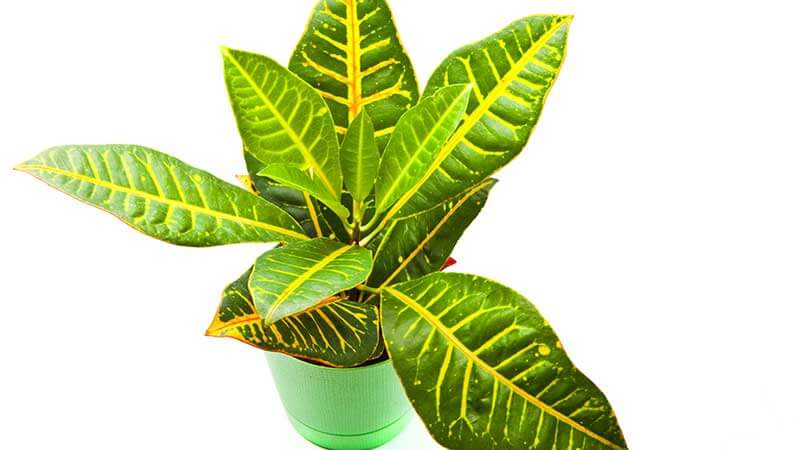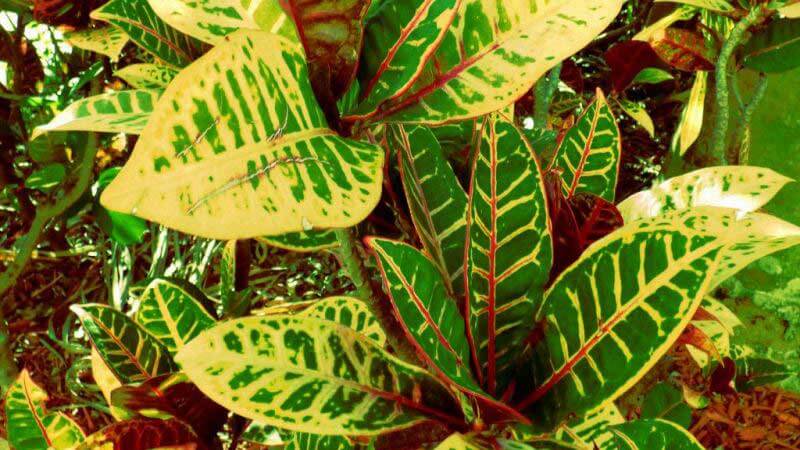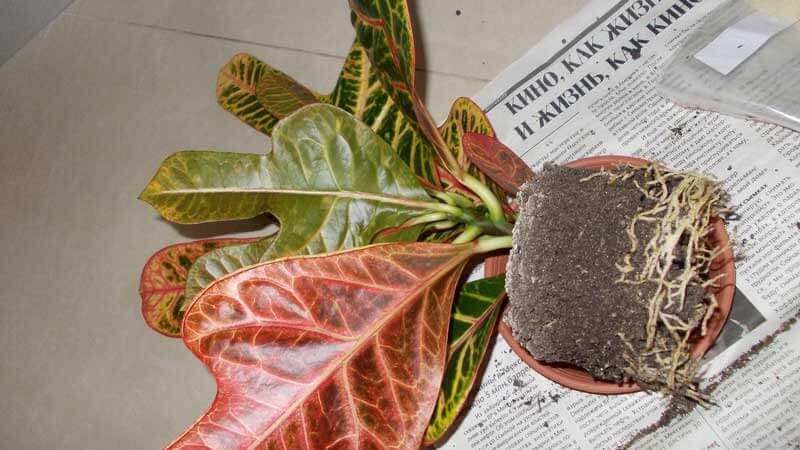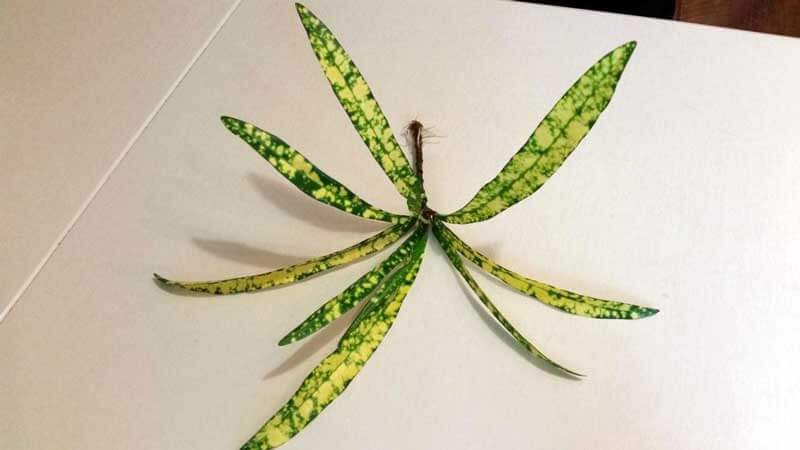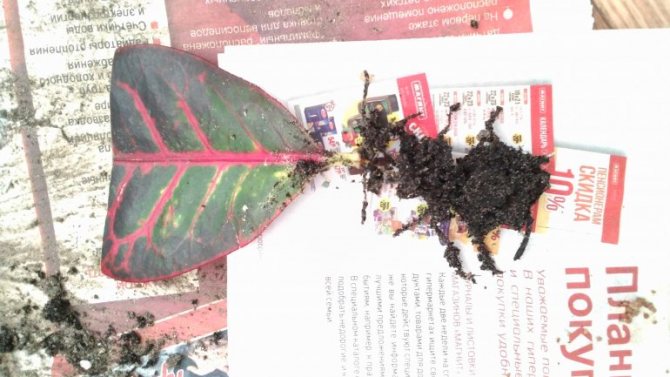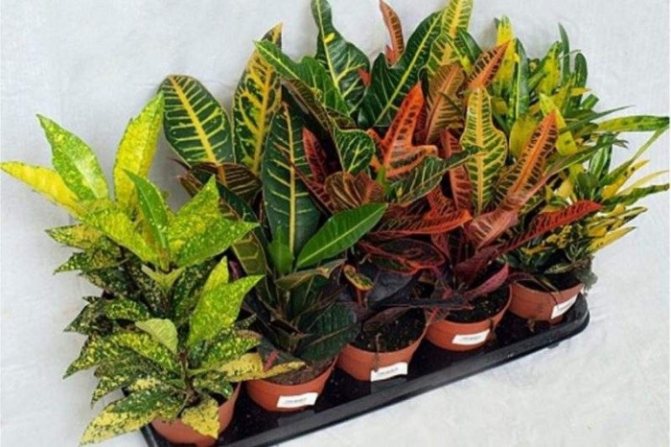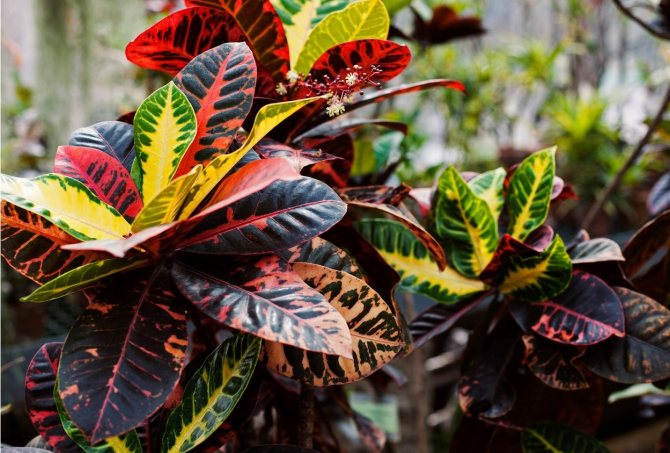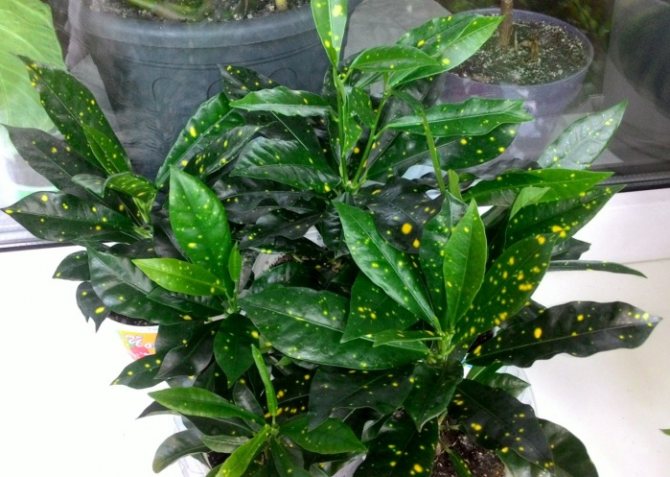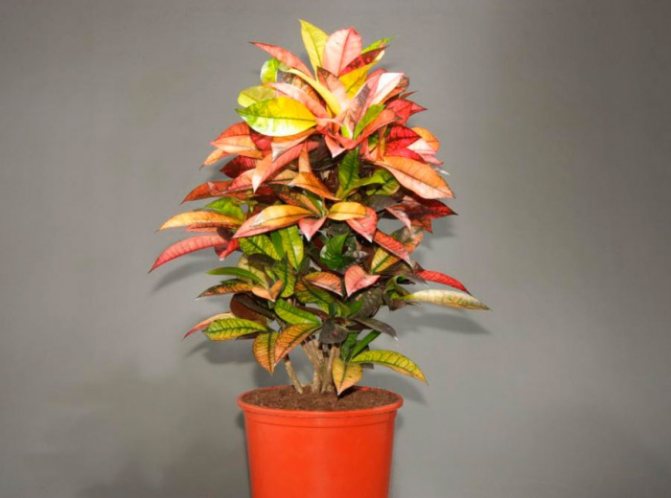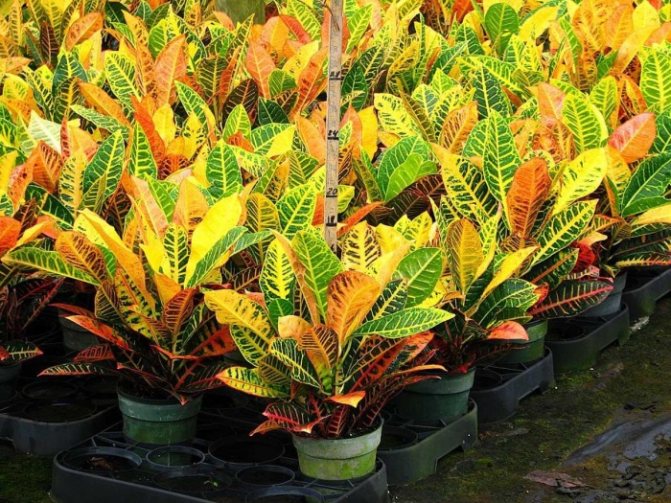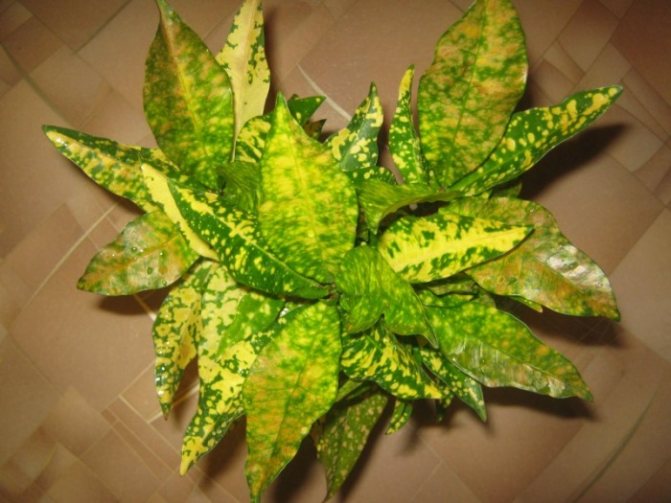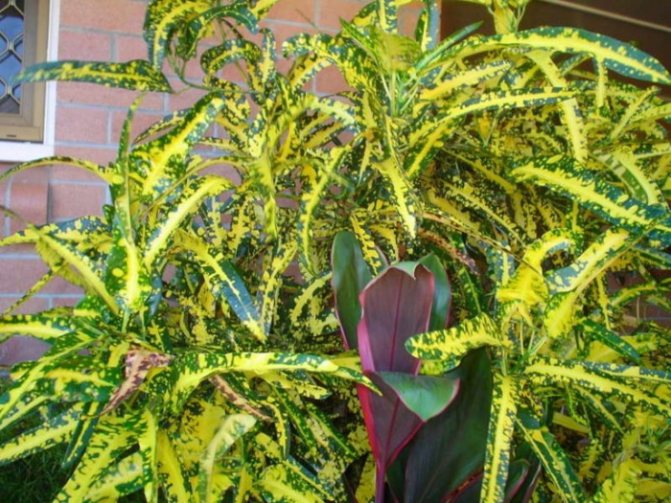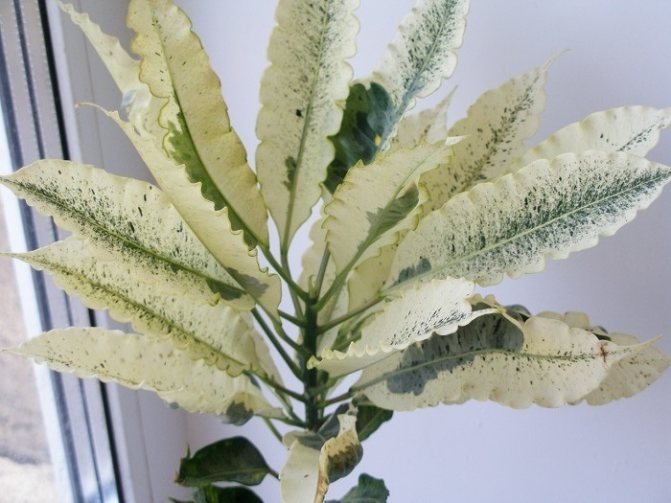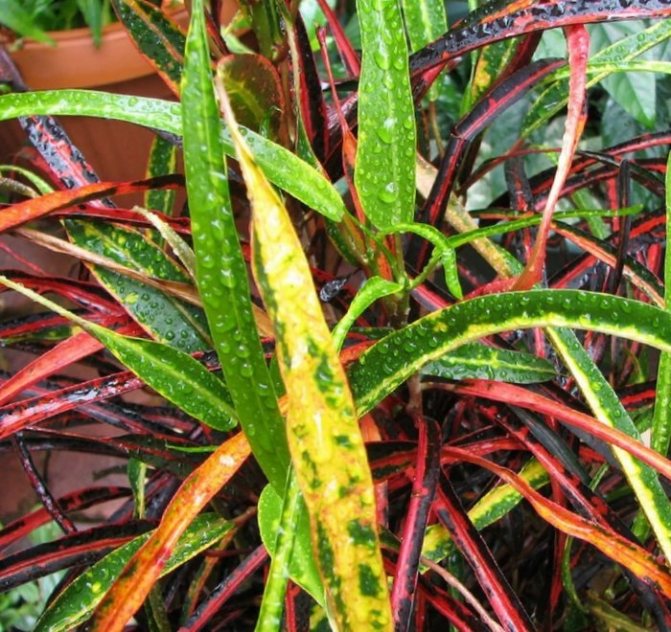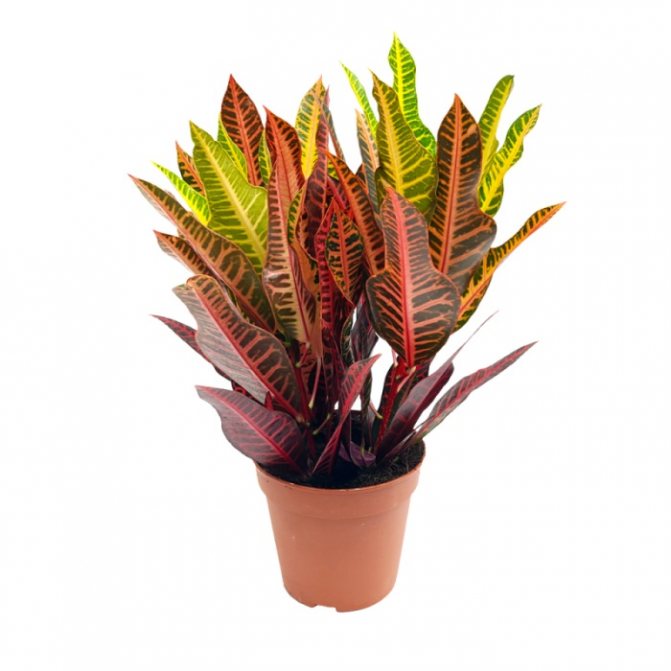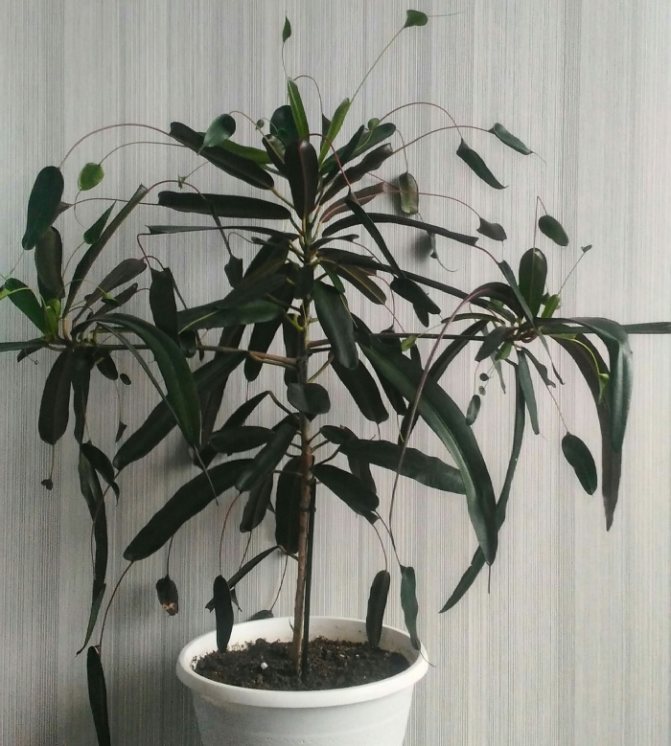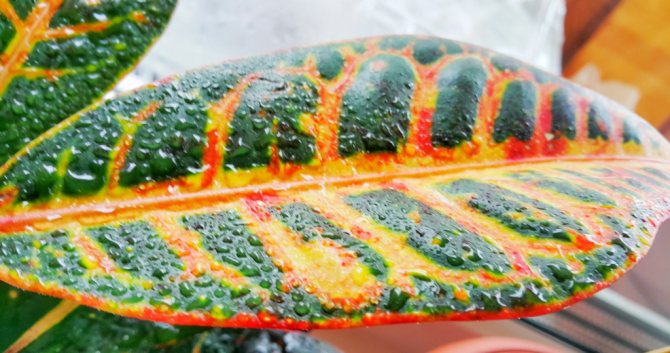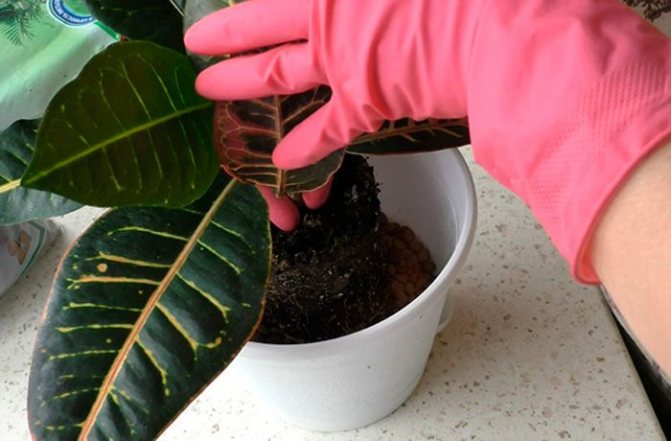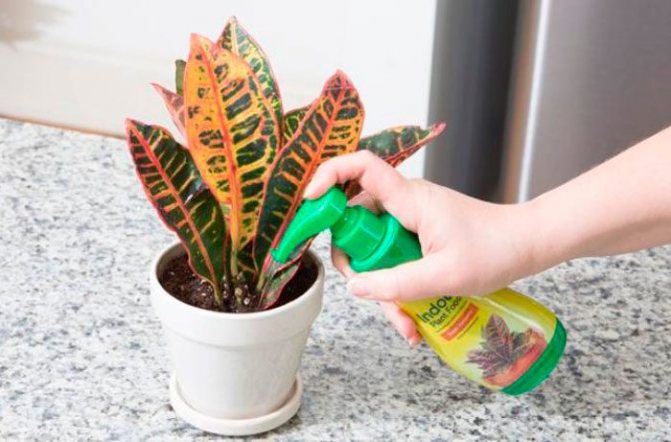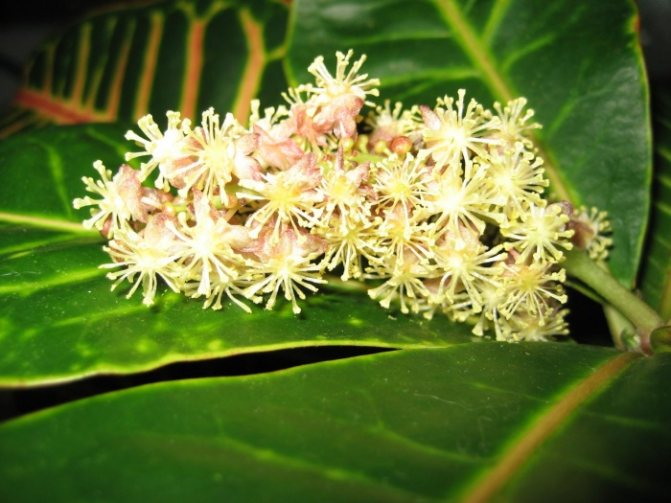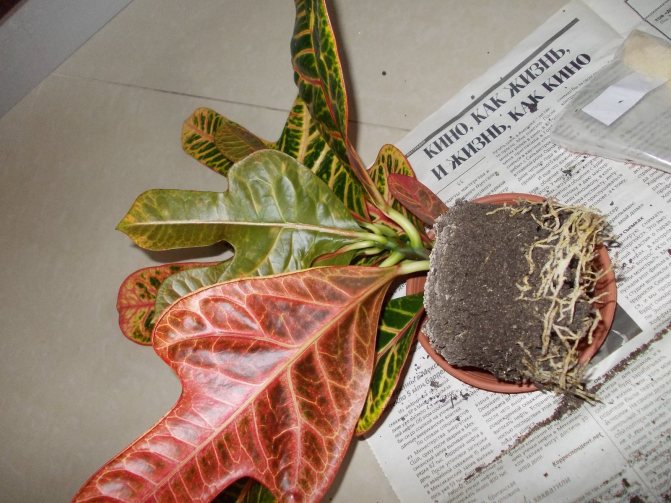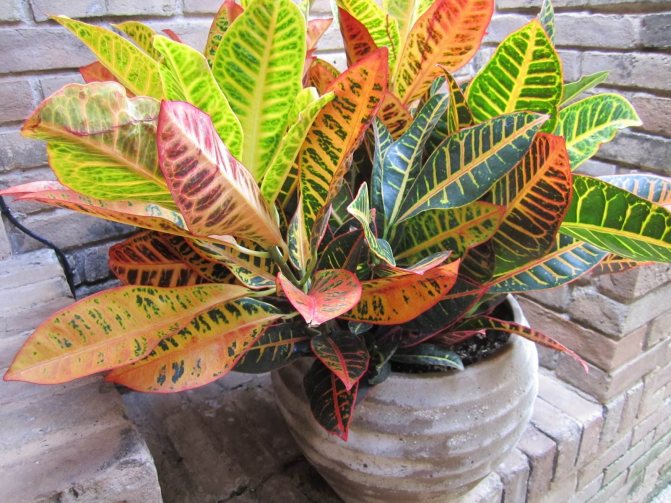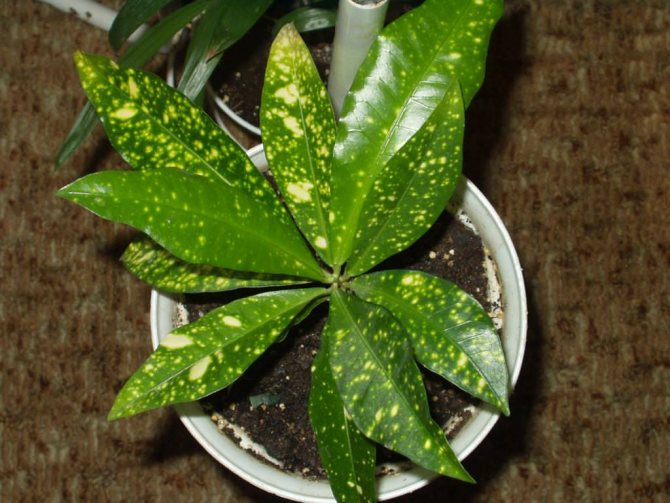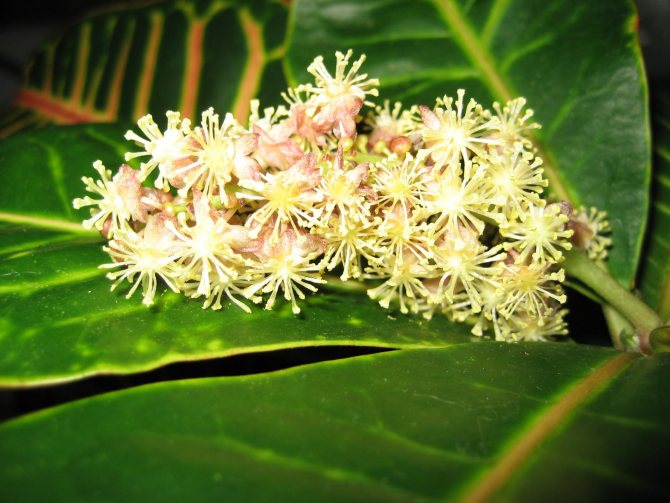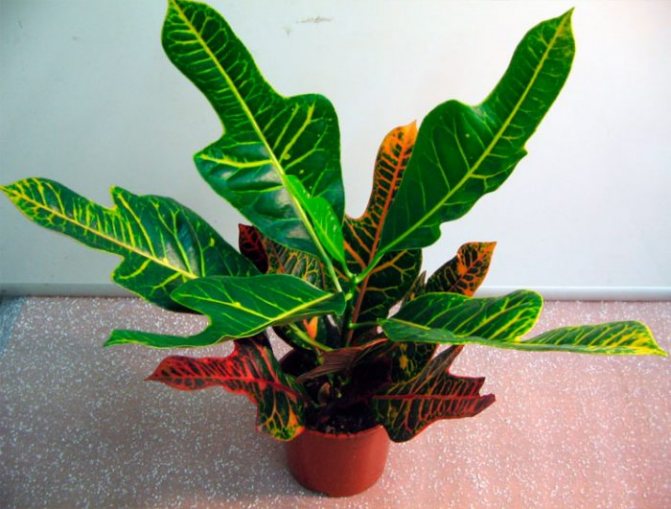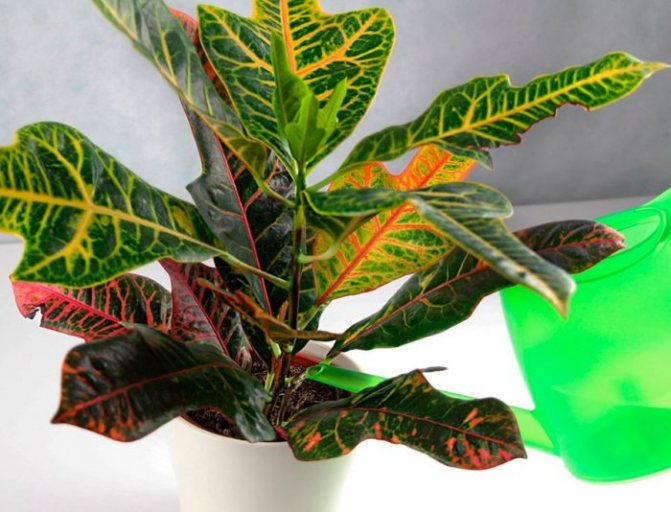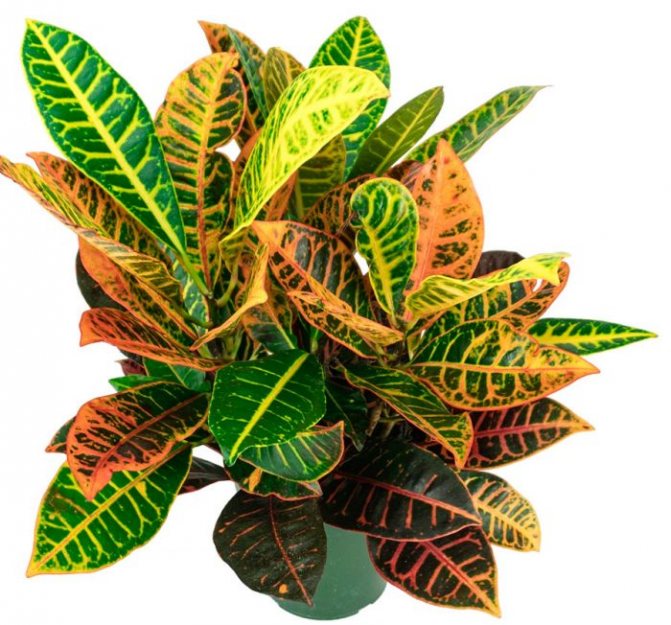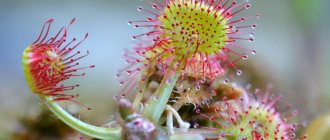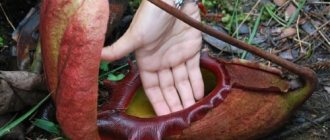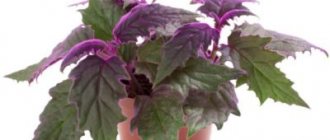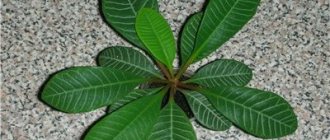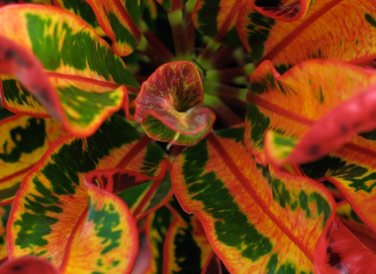
Name: Croton, codiaeum (Codiaeum variegatum var.pictum)
Family: Euphorbiaceae (Fam. Euphorbiaceae)
Homeland croton Malaysia and East India belongs to the euphorbia family. Croton, nurtured by the tropical climate of the Malay Archipelago, Ceylon and southern India, has become very widespread.
Large, dense croton leaves are very elegant due to their color: reddish, orange, yellowish tones. The plant is very unusual and beautiful, known as "Joseph's cloak".
There are a great many varieties of Croton, differing in the shape of the leaf, but all have a bright color with yellow veins. The leaf shape is laurel, oak and in the form of straps.


croton species
When growing, there are problems with preserving the lower leaves in winter, so there is an opinion that this plant is annual. But at a constant temperature, the plant will retain all the leaves and will delight the owners with its beauty for many years.
Choice and purchase
You need to choose a plant based on the appearance of the foliage, the lower leaves should be well developed, should not be lethargic and drooping. When transported in winter in cold weather, the plant should not be hypothermic. Ask the seller to wrap the flower in insulation or several layers of newspaper.


flowers croton
The origin of croton
Croton, or codiaum, is native to the tropical and subtropical regions of Indonesia, Southeast Asia, India and some of the Pacific islands. It first appeared in Europe in the first half of the 19th century.
Croton is a plant with a dense, smooth, erect stem, from which a large number of lateral processes depart. Some species do not have a trunk, the leaves extend immediately from the root.


Croton
Under natural conditions, the plant reaches a height of 4 meters and even more, in indoor conditions - up to one meter.
Belongs to the Euphorbia family. Croton juice is poisonous, therefore dangerous for animals and humans. If it gets on the skin, it can cause irritation, if it gets into the stomach, it can cause vomiting and diarrhea. Therefore, when caring for a plant, flower growers observe safety precautions: they put gloves on their hands. After work, tools and hands should be thoroughly rinsed with water.
Important! In the house, the codiaum is located in places where animals and children cannot reach.
Homeland
Southeast Asia, Malaysian Islands, Pacific Islands and India.
In natural surroundings, the height of Croton no more than 300 centimeters, and in a room environment, at home, the plant hardly reaches a height of 150 centimeters, even with careful follow-up of croton maintenance guidelines. Nevertheless, this small tree will decorate your home all seasons.
There are many types of croton, they all differ in size, color and leaf shape. They are very popular: Motley, Petra, Excelent, Tamara.
How the houseplant croton blooms
Croton - reproduction at home
The flowering period is late February-early March.
The flowers are white with a yellowish tinge and are rather inconspicuous. Formed in the leaf axils of the plant. Collected in a medium-sized panicle, which is located on a dense peduncle.Bright sunlight stimulates the appearance of flowers.
Flowers are dioecious. Usually, female flowers appear first, then male flowers. The flowering period is about a month.
Croton blooms greatly weaken the plant, so they are usually removed.
Growing features
The plant takes a long time to get used to new conditions when buying or transplanting. For the good health of croton, it is necessary to maintain a comfortable temperature and humidity for it.
In order for the codiaum to retain the pattern and brightness inherent in the variety, it is necessary to provide it with a long daylight hours and bright lighting. However, it is worth remembering that the scorching rays of the sun can burn leaves on the leaves. Therefore, when placing a plant on southern windows, you should think about shading so that the light is bright, but diffused.
Croton leaf descriptions
Geranium - home care, how to water geranium
The perennial has tough and leathery leaves, resembling ficus leaves, located on petioles. Depending on the species, they can be ribbon-like, curled, narrow, wide, large and small, have a shape from three-toed to oval, smooth or slightly wavy edges.
The color of the leaves can also vary depending on the species. There are plants with pink, dark green, olive, chocolate, raspberry, red leaves.
The relief pattern is clearly visible along the veins.
Attention! Usually croton leaves are two-colored, but there are species in which the color of the leaves consists of 5-6 flowers.
Young leaves are usually green or yellow in color. Over time, they can change color, spots of different colors appear on them, and the bush takes on its bright and beautiful appearance.
Signs and superstitions
Codiaum protects the hearth, it is the leader among domestic plants, absorbing negative energy.
- The flower has a positive effect on any emotional outbursts of people. If it is depression, Croton directs energy flows to increase self-esteem and give inner strength to a person. Outbursts of aggression and excessive activity are attracted by the wide leathery leaves.
For people who are determined to change their lives, Croton will become an irreplaceable assistant in this difficult matter. According to Feng Shui, this flower creates a comfortable atmosphere, filling the space with purified energy. According to the teachings of Feng Shui, plants should not be too close to the bed.
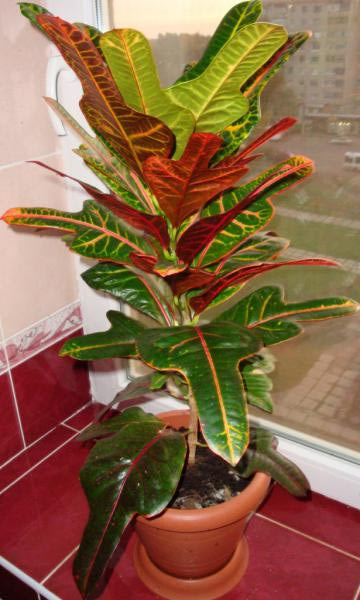

- Croton blooms rarely and this is considered a bad sign. Perhaps the flower senses the approach of danger in the form of a release of negative energy and warns the owners about this. It is better to cut off the appeared inflorescences immediately: this will prolong the life of the plant, and it is better for warned people to be vigilant in business.
If you decide to buy croton, then you need to do it in the spring. The environment comes to life, the air temperature rises, daylight hours increase, and the flower will have enough time to adapt to a new place.
Types and varieties of croton
Plant predator nepentes - home care
Currently, more than 1200 species of croton are known. However, only codiaum Variegatum, its varieties and hybrids derived from it are suitable for growing at home. Currently, most of the hybrids are bred by US breeders.
Dragon look
The homeland of the plant is America. It got its name from the red resin, somewhat reminiscent of blood. Mature plants look like trees with a thick trunk.
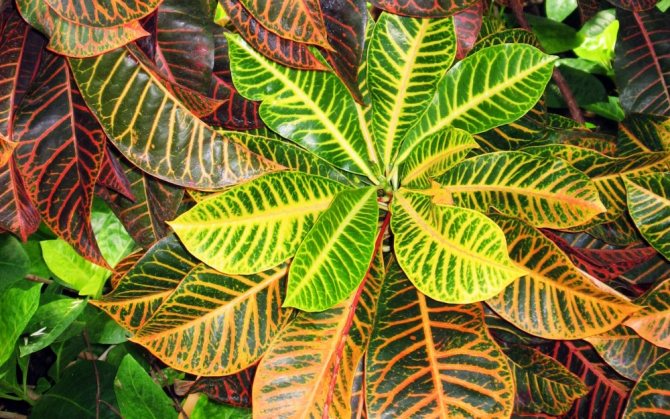

Dragon croton
This resin is used in the manufacture of varnishes, as well as in folk medicine, as it has good antiseptic and analgesic properties. It is used in the treatment of various kinds of ulcers, for the healing of wounds. Resin preparations are prescribed with reduced immunity.
Croton Cascarilla or Euteria
Under natural conditions, Cascarilla is a small tree. The bark has a pleasant sweetish smell.It is used in the preparation of aromatic oils.
In medicine, oil is prescribed for diseases of the respiratory tract or stomach. It has antiseptic properties, so it is used for skin inflammation. In cooking, it is used to make a fragrance for liqueurs.
Prickly croton
The shrub resembles a dragon croton not only in appearance, but also in properties and scope.
The color of the leaves is green and red.
The resin is used in the paint and varnish industry for the manufacture of varnishes.
Laxative Croton
The homeland of the plant is Asia. Can grow as a shrub or small tree, depending on conditions.
Seeds are a valuable raw material for pharmacology. They are used to produce oil, which has a laxative effect.
The oil is used in homeopathy, cosmetology, medicine. It is used to treat eczema, herpes and constipation. However, the seed oil of Croton laxative is poisonous. During treatment, you must strictly adhere to the dosage so as not to harm the body.
Variegated croton
This is the most common type. On its basis, many different varieties and hybrids of crotons were bred as indoor plants for growing at home.
Leaves can be of different shapes: from spiral to oval. Painted in at least two colors. Usually these are combinations of colors of yellow, green, brown, pink and red.
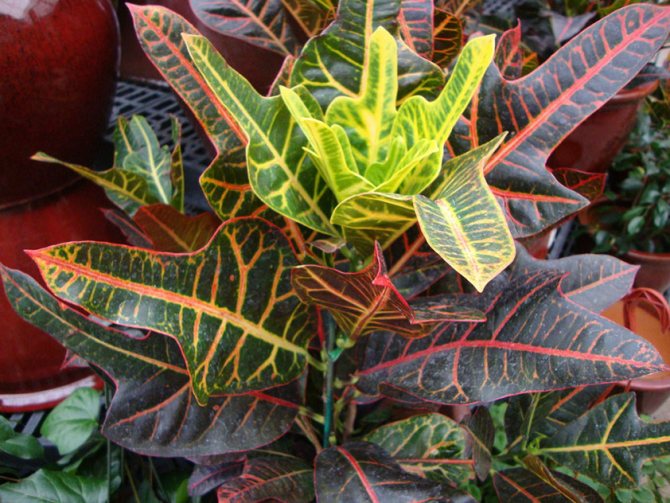

Croton variegated
Three-bladed crotons
The shape of the leaf plate of this type resembles an oak leaf. Visually, it is divided into three parts, with the central part being larger than the lateral ones.
The leaves themselves are large, tough, leathery. The color is combined of green, yellow, red, brown, burgundy and other colors.
This type includes codiaums:
- Exilent;
- Nervia;
- Disraeli;
- Holuffianaa.
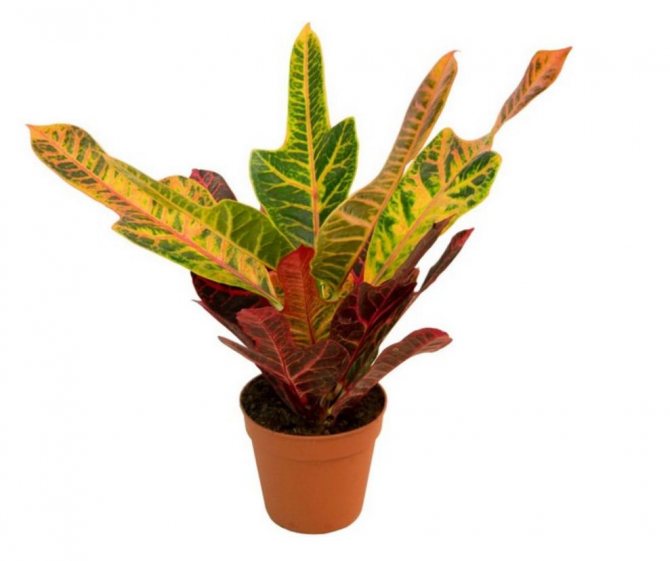

Croton Exilent
Narrow-leaved crotons
This variety includes plants with long but narrow leaves. They are used in the design of not only residential premises, but also offices.
The most optimal conditions for development are diffused light, warm moist air and moist soil.
This group includes:
- Mummy;
- Sunny is old;
- Zanzibar;
- Splashes of champagne.
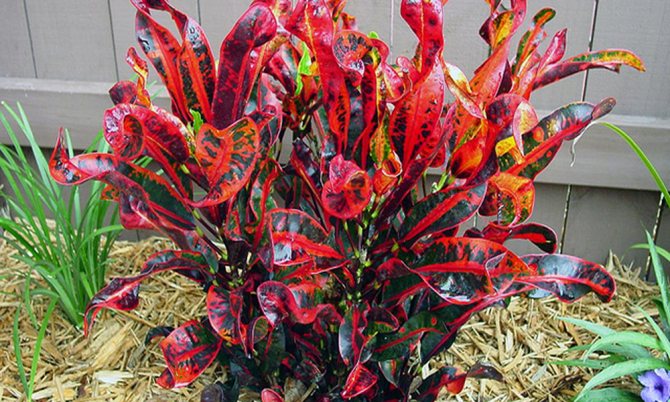

Croton Mummy
Leaves are usually up to 30 cm long. Under favorable conditions, the plant can reach 1 m in height.
Lobed varieties of crotons
In this type of codiaum, the leaf plate resembles three-bladed varieties, but only it is solid.
The shape and dimensions of the sheet plate may also differ depending on the variety.
This type includes:
- Peter;
- Gold Sun;
- Mrs. Aiston.
You can also see Croton Variegatum Mix on sale. In the case of selling mixed plants, it is not a specific variety of indoor croton flower that is offered, but a cluster of several varieties and hybrids of codiaums, which can be difficult to identify.
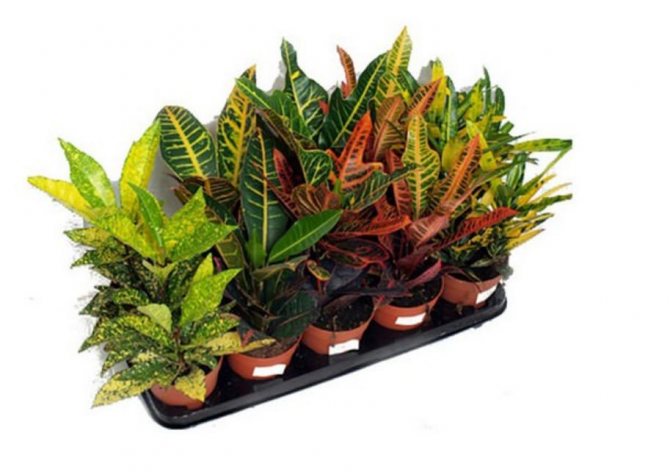

Croton mix
Croton transplant after purchase in open ground
After purchasing codiaum, it is recommended to transplant the plant into another soil, because the substrate used for transporting seedlings is not always suitable for long-term cultivation.
However, the croton flower should not be replanted on the same day it was purchased. Planting can be started after at least 10 days. During this time, the plant acclimatizes and transplant is easier.
For young bushes, it is recommended to transplant every year, adults - no more than 1 time in three years (as the root system grows).
It is best to transplant a bush in the spring or early summer.
Attention! You can not transplant a croton flower during the flowering period.
What you need to plant croton
For optimal growth and development, codiaums need light and fertile soil. To independently prepare the substrate, they take sod land, fine sand, humus and peat in equal proportions.All components of the substrate are thoroughly mixed.
Additionally, you can add a little charcoal or ash to the soil. This will prevent the spread of putrefactive diseases in plants.
For planting, you can purchase a universal soil for indoor plants in a specialized store. Also, for transplantation, it is necessary to prepare a flower pot with a diameter of 3 cm larger than the previous one, made of plastic or clay. An important condition is that it must have large drainage holes.
Choosing the best place
A warm, sunny place, without drafts, is best suited for growing codiaum. With a lack of lighting, the leaves will lose their variegated color and become monochromatic.
Direct sunlight will not be able to harm the leaves, but it is preferable that the light is diffused. It is best to place the flower on a window that faces west or east.
In order for the codiaum to feel comfortable and develop normally, the surrounding air must be humid. You should not place the flower next to heating devices that dry the air greatly.
Step-by-step planting process
- First of all, you need to prepare a flower pot.
- Sterilized drainage is poured at the bottom. It can be crumbs of broken red brick, expanded clay, polystyrene, etc.
- Part of the soil mixture is poured onto the drainage, which is slightly tamped and moistened.
- A plant is taken out of the pot. Be sure to monitor the integrity of the earthen coma. It shouldn't be destroyed. It is better to use the method of transferring from one pot to another.
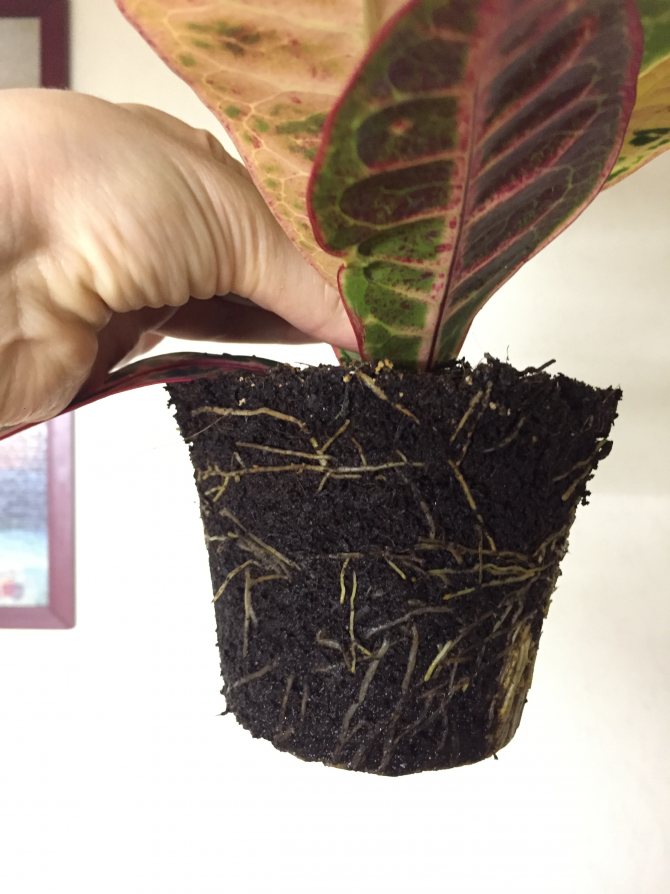

Croton transplant
- Inspect the root system. If rotten roots are noticed, then they need to be removed.
- Place the flower in a pot and cover the pot with the remaining mixture. In this case, you need to ensure that no voids remain between the earthen lump and the walls of the pot. The container can be shaken periodically so that the earth evenly covers the free cavities.
- After transplanting, the soil is moderately watered, the leaves are sprayed with water and the pot is placed in a warm, shaded place.
If there is no desire to grow a tall croton flower, then there is no need to transplant. If the ground is covered with a white coating, then you can just update it a little. To do this, carefully remove the top layer of soil (3-5 cm) and pour new soil on top.
Diseases and pests
Frequent watering, leading to acidification of the soil and too dry air are the main reasons why croton can get sick or be exposed to pests.
Table: diseases and pests characteristic of croton
| Diseases and pests | Symptoms | Control measures | Prevention |
| Anthracnose | Brown spots of various sizes appear in the center of the leaf, along the edges. The stains gradually dry out. Young shoots stop growing. The plant dries up gradually. |
rinse the root system in a weak solution of potassium permanganate.
Fitosporin.
use Fundazol or Speed. |
temperature conditions, observe the humidification regime.
damage to croton.
selected fertilizers. |
| Root rot | The leaves begin to turn yellow, turn pale and fall off. The roots soften and lose their vitality. |
at the initial stage.
from the old soil, rinse the roots.
including diseased leaves.
excess strength, you can trim the tops of the shoots.
soil mixture.
sun, place.
new leaves will appear.
it is best for him to part. |
attention to the condition of the plant.
leaving. |
| Spider mite | It sucks out intercellular juice, weakening the plant. Stains remain at the puncture sites. Croton becomes lethargic. The pest is easy to find out on a thin cobweb. | Treat croton with one of the drugs: Fitoverm or Actellic. The solution is prepared according to the instructions. Handle in personal protective equipment, with an open window or outdoors. |
the required humidity.
you need to redeem croton under the shower, washing off insects with water.
moistened with soapy water, remove pests from the leaves and trunk. |
| Mealybug | The pest is visible to the naked eye. The main signs are: sticky plaque; cotton-like plaque; suspension of the development of croton. | ||
| Shield | Sucking pests, hiding behind a shell that looks like a brown tubercle. Weaken the plant. If measures are not taken in time, they can cause the death of Croton. |
Photo gallery: how diseases and pests manifest themselves
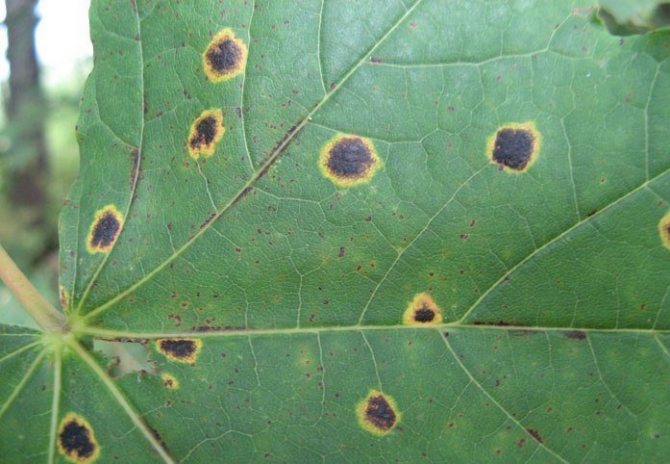

This is how anthracnose appears on the leaves of indoor plants.
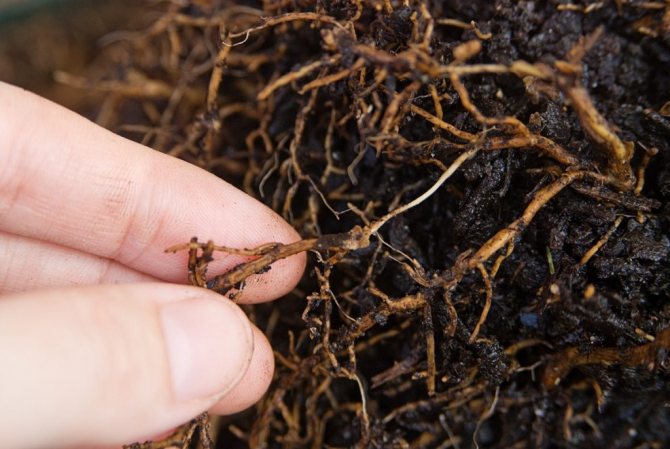

Root system affected by rot
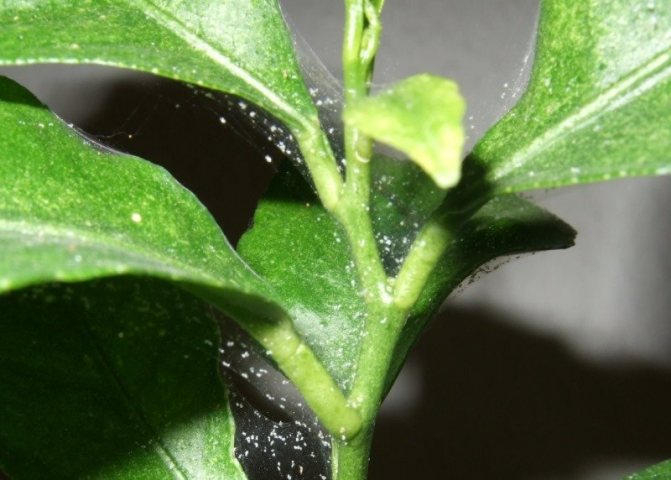

A spider mite can be easily identified by the spider web that appears on the plant.
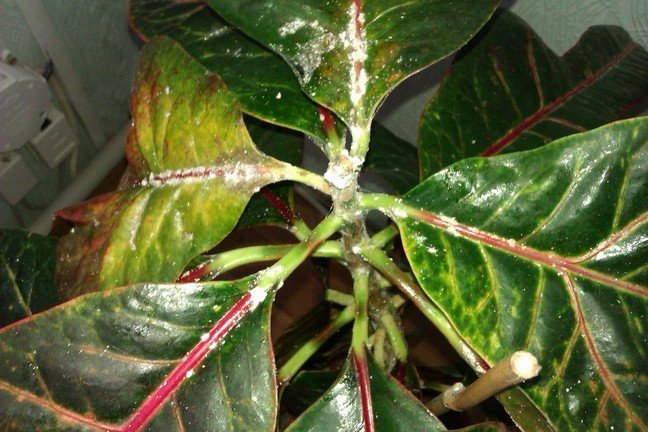

On the bright leaves of the croton mealybug, you can immediately notice
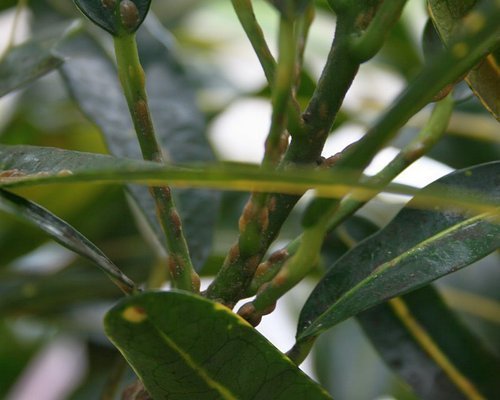

Croton struck by a scabbard
Croton reproduction
A plant can multiply in several ways:
- cuttings;
- layering;
- seeds.
Propagation by cuttings
To obtain high-quality cuttings, lignified healthy shoots are selected. The stalk is cut from the tip of the shoot 7-10 cm long with 2-3 leaves.
The cut of the shoot is dipped in a glass of water and kept for several hours. Thanks to this procedure, the milky juice on the cut will not be able to dry out. Then the stalk is taken out of the glass, the remaining juice is removed and placed in a container with a sand-peat mixture. The cuttings are placed in a bright place. The air temperature in the room must be at least + 25 ° С.
After about a month, roots form on the cuttings. After rooting, the plant begins to actively release shoots.
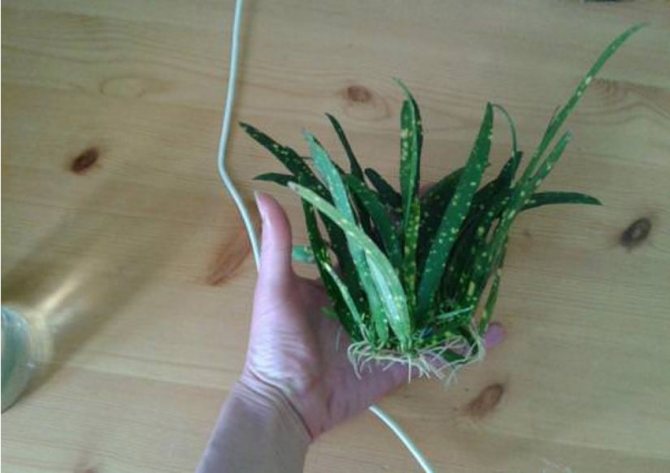

Propagation by cuttings
It is better to propagate a flower by cuttings in spring or early summer.
Growing from seeds
The seeds are harvested on their own or purchased from a store.
Seeds are sown on the prepared sand-peat mixture and slightly crushed on top with the same mixture. They are pre-soaked in Kornevin's solution for better germination.
Then the container is covered with plastic wrap and placed in a warm place. It is recommended to ventilate the greenhouse daily. If the soil is dry, then the soil is sprayed. A month after sowing, seedlings appear.
Croton home care
Many novice growers do not know how to care for croton at home. In principle, this is not difficult, although there are some nuances.
Watering mode
Codiaum is a tropical plant, for which one of the important conditions for normal development is high air humidity. It should be 70-80%. Therefore, it is important to regularly water the plant and spray the leaves with water.
In the hot season and during the heating season, spraying with warm water from a spray bottle will greatly benefit the plant. You also need to periodically wipe the surface of the leaves with a damp cloth.
Attention! Dry air and dry soil will cause leaves to fall off. In addition, dry air favors the reproduction of weevils and spider mites - plant pests.
For irrigation, you need to use warm, settled water. The soil of the flowerpot should be moist at all times, but not waterlogged. Usually, watering is carried out in the warm season 2-3 times a week, in winter - 1 time.
Top dressing
In the spring-summer period, Croton is fed with a solution of mineral fertilizers, which is used for deciduous plants. The frequency of fertilization is 1-2 times a month.
In winter, feeding is not performed or carried out, but not more than 1 time.
Preparing for winter
In winter, the daylight hours for a plant should be at least 12 hours. Therefore, it is imperative to organize artificial lighting. If you do not arrange the backlight, then the leaves will lose their motley color.
The ambient temperature should not fall below + 17 ° С. Optimally, it should be within + 18-20 ° С.
Flowerpots should be away from cold window panes and away from heaters.
Thus, caring for croton at home is simple, you just need to follow some rules so that households can be pleased with this beautiful and festive flower with bright colors.
Possible problems when growing croton
Subject to all the rules of care, the flower is not afraid of any diseases and insects. Their appearance suggests that Croton does not like the conditions of detention.
Irregular watering, dry indoor air, and occasional spraying can cause spider mites, scale insects, or mealy worms to appear on the flower leaves. In the early stages, pest control can be done with folk remedies. To do this, the leaves and stems of croton are wiped with a solution of tobacco and soap.... After an hour, the bush is rinsed under the shower so that water and solution do not get into the soil. If there are already a lot of pests on the plant, urgent treatment with special chemicals is required.
Codiaum
Why does codiaum shed its leaves?
The plant sheds a small amount of lower leaves during growth. There is nothing wrong with that. However, in case of massive leaf fall, it is worth looking for the cause and eliminating it. Croton leaves can fall off in several cases:
- The plant is standing in a draft.
- Low air humidity.
- Constant insufficient watering.
- Sharp temperature fluctuations.
Why do leaves dry?
The drying lower leaves of a flower are a natural process. In a plant, the lower part of the stem is exposed with age. Dry leaf edges and brown spots indicate that the codiaum is cold., and it urgently needs to be rearranged to a warmer place. Dry leaf tips indicate that the room has low humidity. If the leaves not only dry, but also fall off, then the plant is overdried and its roots lack moisture.
Why did Croton drop the leaves?
If the roots are cold, they stop absorbing moisture, causing the plant to drop its leaves. In this case, the flower pot must be moved to a warm, well-lit place., water and spray regularly, stop feeding. For a while, it is recommended to put on a transparent bag or cap on the flower.
Despite the fact that a beautiful tropical tree at home looks stable and strong, it still needs proper care. A negligent attitude towards a plant can lead to the appearance of pests, diseases, and even its death.... In order for Croton to delight with its decorative foliage all year round, it needs to be surrounded with attention and care.

